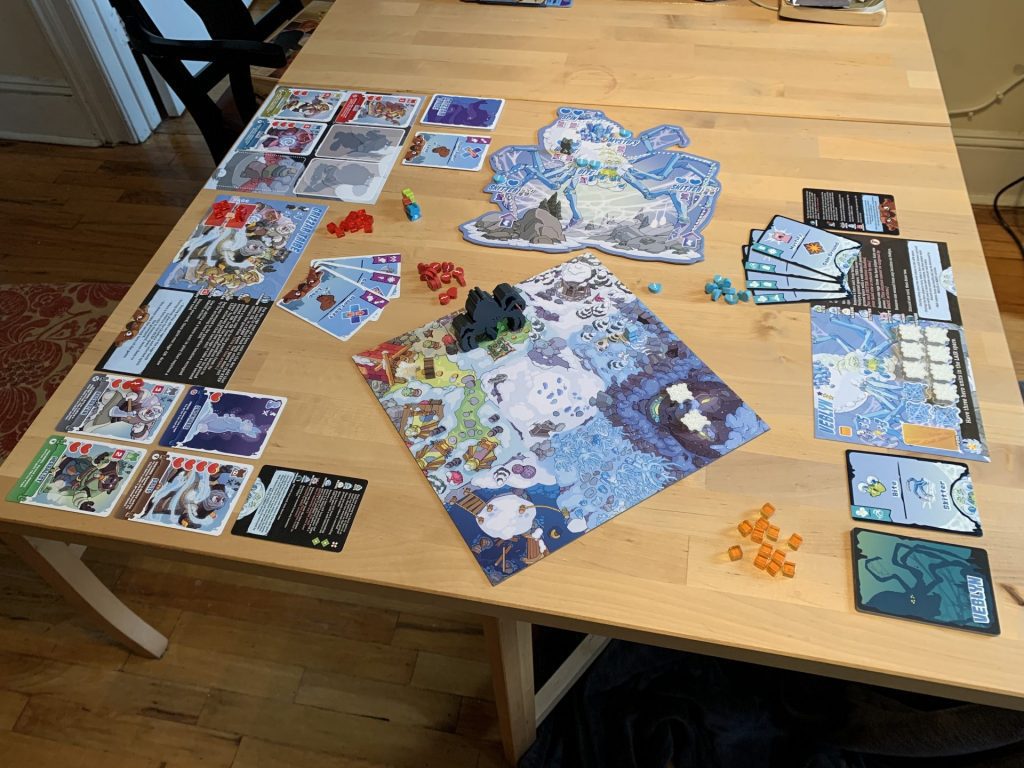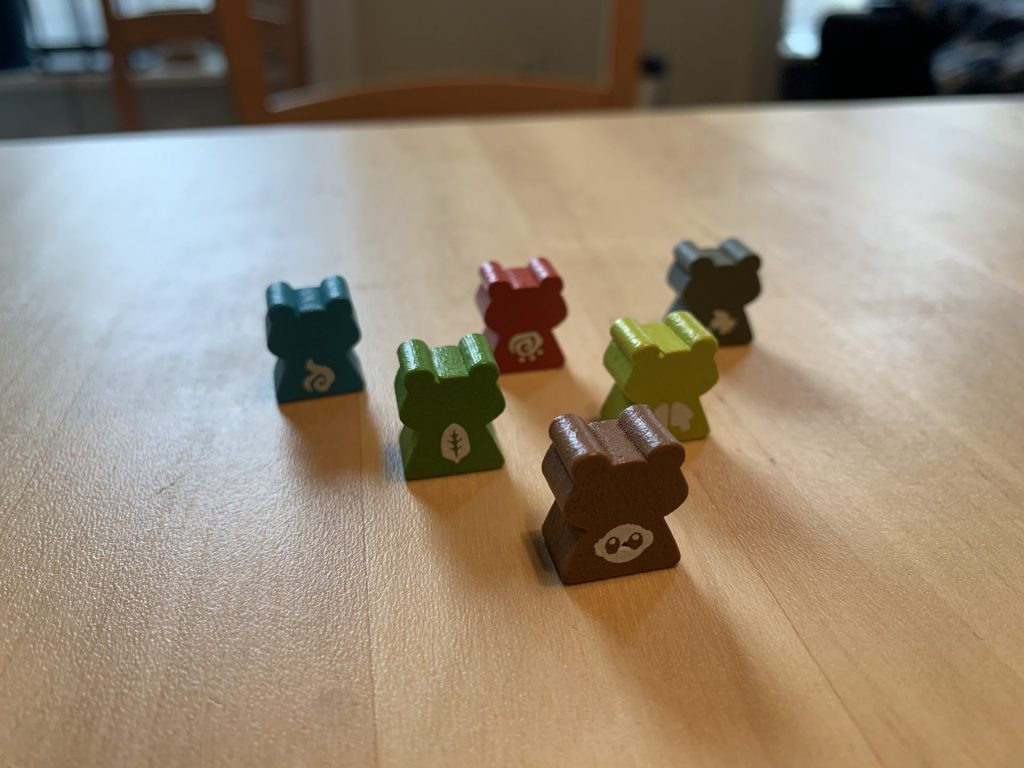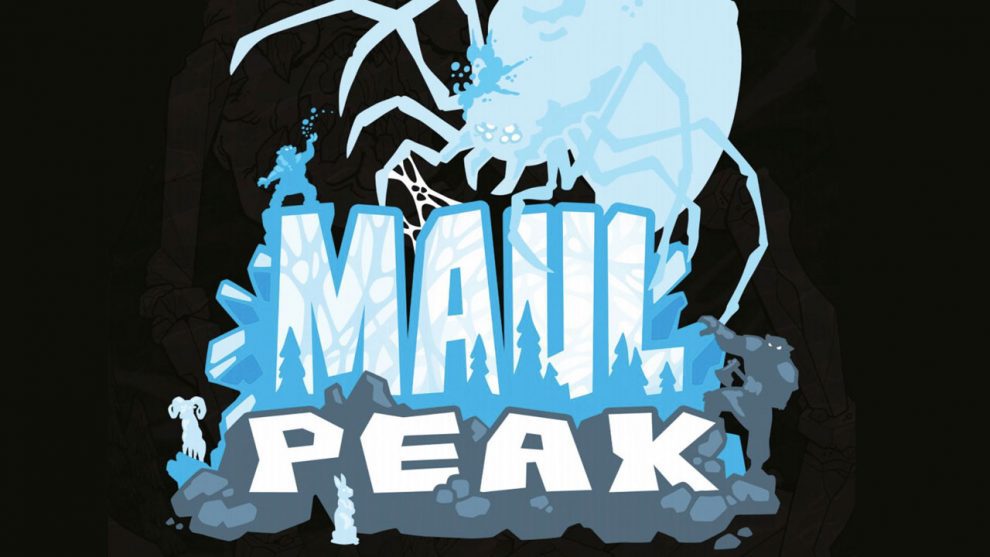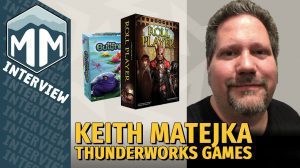Disclosure: Meeple Mountain received a free copy of this product in exchange for an honest, unbiased review. This review is not intended to be an endorsement.
Maul Peak is a two-player skirmish game featuring asymmetric roles. Each player controls one of two factions: the scrappy Grizzar or the rampaging Guardian. The Grizzar’s goal is simple: defeat the Guardian, but the Guardian’s end goal is largely dependent on which Guardian is being played. And, since this is a game featuring asymmetric roles, each faction functions very differently from the other.
Driven by rage (the currency used to bring their characters into play as well as power their abilities), the Grizzar player will be attempting to attach their units to the Guardian to attack it and reduce it to zero health. Their faction deck contains cards to assist them in this endeavor: movement, attack, and healing cards, for example.
Each Guardian has a generic win condition (remove all of their opponent’s units from the game board, even if their opponent still has units in reserve that haven’t been summoned yet) as well as its own unique one. And, like the Grizzar player, the Guardian player’s deck of cards is designed around achieving one of these goals.
On a player’s turn, they will take a number of actions, determined by the limit set on their player board. First, they can select one of the cards to play from their hand and then carry out one of the actions printed on it. Secondly, each player has a special action they can perform to add cards to their hand. And as if that wasn’t enough, each player has the ability to spend the energy stored in their respective pools (Rage for the Grizzar and Power for the Guardians) to perform additional actions that don’t count towards their action limit.
Will the hearty Grizzar fend off the Guardian’s assault? Or will the Guardian win the day, relegating the Grizzars to the annals of history? It’s a fight to the death!
Of course, this is a high-level overview of the game. If you’d like to get a better idea how Maul Peak works, keep reading. Otherwise, feel free to skip ahead to the Thoughts section to see what we think about the game.
Setup

To begin, each player chooses a faction and takes the components for that faction into their control. The Grizzar receive their deck of cards, their Grizzar meeples, their player mat, and their Den board. Each of the different Grizzar hero cards are separated and placed on top of the matching illustrations of their Den board with the matching meeples set atop those. This will leave only the Druid which is set off to the side (along with its meeple) and a Winter Beast card, selected at random (along with its meeple as well).
The Guardian player receives their player mat (along with any Guardian specific items such as Saboso’s Shiver tokens), their deck of cards, and their Guardian meeple. There will also be a mat associated with the selected Guardian. This mat is placed in the center of the table.
Unlike most square game boards where opposing players play from across opposing edges, the game board for Maul Peak is played from corner to corner. After placing the game board between the two players, beside the Guardian mat, the players will place the meeples they set aside into their starting locations on the board: the Guardian meeple on the Lair and the Druid and Winter Beast on the Keep.
Then set aside the Wound tokens and the Rage and Power cubes and you’re ready to begin. In Maul Peak, the Guardian will always take the first turn.
The Grizzar

As mentioned previously, the Grizzar’s goal is to reduce the Guardian’s health to zero. This is accomplished by spending Rage to summon hero units onto the board from the Den, using cards to move units around the board, and then leaping onto the Guardian in order to attack the various locations on its body.

Each location on the Guardian’s body is labeled with a word matching one of the Guardian’s abilities. If every location bearing the same title has received maximum wounds (i.e. – the spaces are covered with Wound tokens), then that ability becomes unavailable to the Guardian until the Guardian player is able to remove one of them.
In general, the Grizzar’s main priorities are gaining Rage, spending Rage to bring extra units into play, and then using those units to launch a coordinated assault.
The Guardians

The Guardian player has two ways to win the game. The first is to remove all of the opposing player’s units that are in play from the board. The second depends entirely upon the Guardian. Consider Saboso, for example (the Guardian the rulebook suggests playing in your first game). Saboso’s goal is to attach Shiver tokens to their opponent’s pieces so that they can then use Saboso’s TRAP ability to capture those pieces and remove them from the game. If they are able to capture four of the opposing player’s units in this way, they win.
The Guardian’s main priorities are moving into spaces containing their opponent’s pieces and then using their special abilities effectively to pursue one of the two win conditions.
Thoughts
In my late teens and early twenties, I was introduced to the old video game Age of Empires (AoE). In AoE, you start out with virtually nothing, a handful of workers and a single building. In order to build and advance your empire, you’ve got to send these workers out to collect and bring back resources. Gather enough resources and you can start building new buildings which open up access to new technologies and new unit types. What starts out as a peaceful, idyllic game quickly descends into total chaos as the different nations begin warring with one another to gain dominance over the others. It’s a game of player elimination with the goal being to wipe out everyone that isn’t you from existence. It’s also the game that destroyed my taste for aggressive games.
I played pretty frequently with a friend of mine who we’ll call Timmy. Timmy wasn’t into the peaceful, idyllic side of AoE. He preferred to live among the chaos. I can clearly recall his mad cackling as he would harass my workers. I can still hear his evil laughter as he systematically destroyed everything I’d worked so hard to build. His maniacal utterances coupled with the alarming sounds the game would make every time something of mine was being attacked (and with him playing, it would play that sound constantly) had a profound psychological effect on me. It made me angry. Like seeing red, unable to think clearly angry. And I’m pretty sure he knew it. If he hadn’t pressed my buttons, maybe I could have remained calm and maybe he wouldn’t have been as successful as he was at that game and maybe, just maybe, I would have grown up to be the kind of person that would truly appreciate a game like Maul Peak.
But he did what he did and I am what I am with the net result being that I really just do not like Maul Peak.
Don’t get me wrong. There’s nothing wrong with Maul Peak. It’s a brilliantly designed and well-balanced game. Both factions feel like either could win at any given time. Each hand of cards presents a lot of different tactical opportunities to turn the tide in your favor as long as you play them right. And there are even processes in place to improve your hand if it turns out to be less than favorable. The gameplay is intense and action packed and you’re never left feeling disengaged. It even looks really nice with awesome artwork, a sleek rulebook, and even sleeker wooden meeples.
The problem is with me. Overly aggressive games don’t sit well with me. They leave me feeling equal parts angry and guilty when I’m done: angry when everything I own in the game is being blasted to smithereens and guilty when I’m the one doing the blasting to someone else. Neither of those are ways that I like to feel. So, when it comes to Maul Peak, even though I am able to recognize what a stellar design it is, I’m just not interested in playing. It turns me into a beast (and not a Winter one). So, to give it a fair shot, I sent the game along to someone that I thought would appreciate it, my fellow writer Andrew Lynch.
Andrew’s Addendum
Once it became clear that David and Maul Peak were not suited to one another, the game began a dangerous trek up the northeast corridor so that I, a man with an appetite for confrontational two-player games, could give it a whirl. The components are lovely. The whole presentation, down to the textured ice-blue insert, is top-notch, with these oversized wooden figures for the Guardians and charming illustrations throughout. The bear meeples are adorable in a way that clashes magnificently with the brutal feel of the game. Nothing quite like taking a moment to appreciate how cute your little figure is before you send it scaling up the side of a giant grotesque spider to stab that spider in the knee.

While you are generally limited to three plays on any given turn, just about every round has you looking at your cards and wishing you could play a fourth. I very much enjoy games that consistently have you wishing you had just one more action on your turn. There’s something about being short a single action that feels like great design—Yellow & Yangtze manages the same trick—and Maul Peak does it beautifully.
I’m not sure how well-balanced Maul Peak is. It is certainly much easier for the Guardian to dominate than it is for the Grizzars, though the fight evens out provided the Grizzar player prioritizes and succeeds at getting their bears out on the board as quickly as possible. In my first game, I made the mistake of trying to take down the Guardian one bear at a time. Don’t do that. It ends badly.
Any game where you have to figure out how to play well is already headed down the right path, and there is satisfaction to be found in playing your turn well. That said, my main issue with Maul Peak is that it’s kind of boring. Constantly climbing up the Guardian to damage different areas on their board gets repetitive. Constantly chasing down the different bears, or moving to shake them off, gets repetitive. It feels like it should be more fun. A lot of love and care has clearly gone into designing it. Nonetheless, Maul Peak falls into that gray area of games that are well made, but don’t have that je ne sais quoi that makes a good game into a great one.












Add Comment